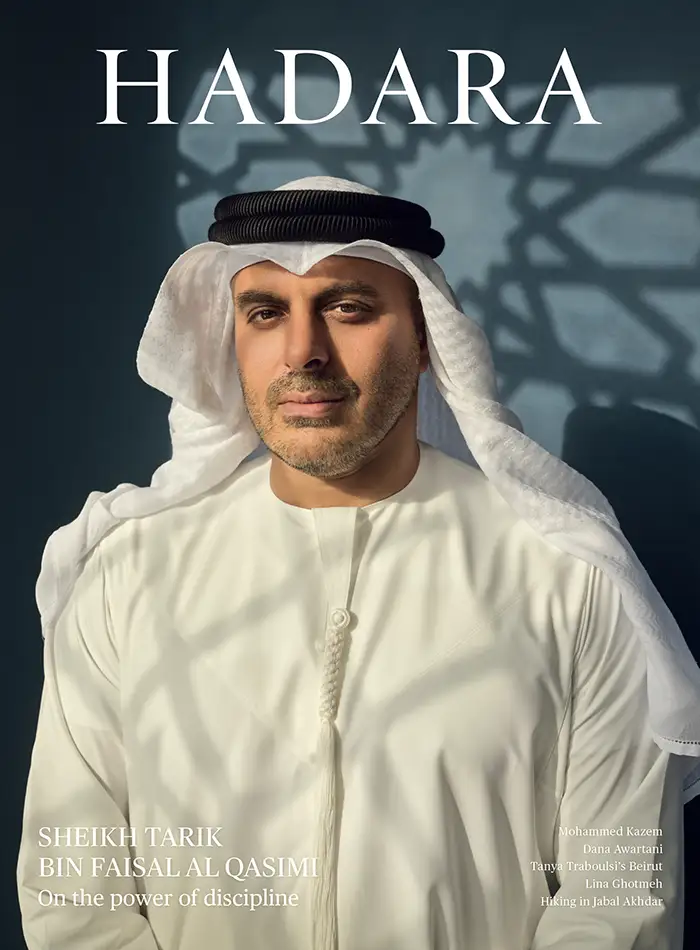Art as life lived
Saudi artist Manal AlDowayan, who is representing her country at the Venice Biennale, is both witness to and part of the kingdom’s cultural metamorphosis.
By Naima Morelli
Forty-five minutes before the preview opening of the Venice Biennale in April, there was already a long line of sleepy people waiting at the Arsenale. Half were elegantly dressed Arab women.
When Saudi artist Manal AlDowayan showed up a few minutes later with a big red smile, she was greeted by a peal of excited squeals. The line scattered, and the artist was cocooned for a group selfie. “They are Manal’s cousins,” explained an amused man in the line.
Most of these women have never been to the Venice Biennale before. It was AlDowayan’s participation that drew them. This was a chance to root for their heroine while enjoying what in Saudi Arabia has become the chicest of activities: art appreciation.
“Saudis have a genuine curiosity about art, and there’s this energy they bring when they encounter an artwork they like and understand,” AlDowayan explained later as she unpacked her suitcase from Venice in her London studio. “This is the art that I want to make: something that speaks to their life experience.”
One of Saudi Arabia’s most important contemporary artists, AlDowayan’s work incorporates sculpture, photography, video, sound, and participatory practice, and frequently explores the representation of Saudi women and gender-biased social norms. She was chosen to represent the kingdom at the 60th International Art Exhibition in Venice, which runs until November 24.
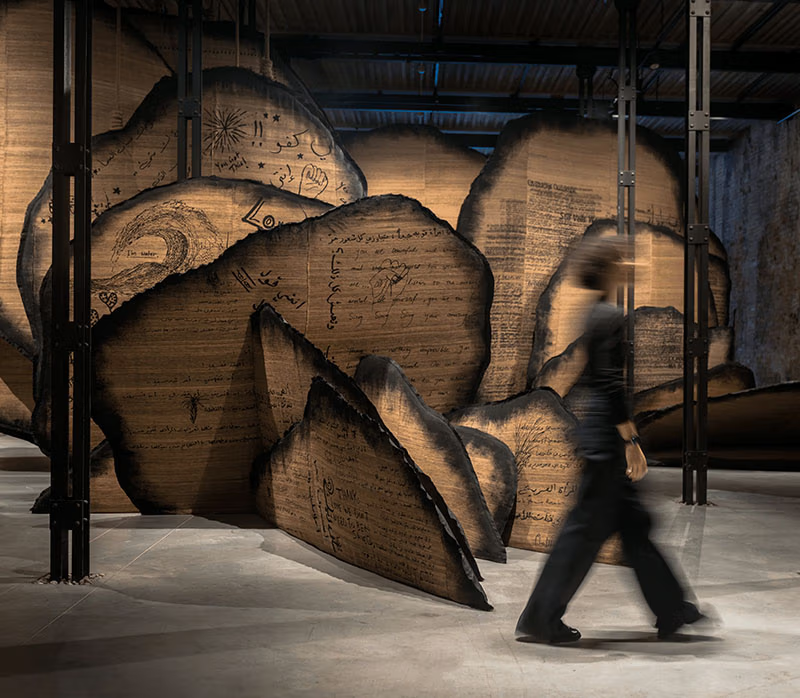
Manal AlDowayan is representing Saudi Arabia at the 60th International Art Exhibition in Venice, with her installation Shifting Sands: A Battle Song (2024). Venice Documentation Project. Courtesy of the artist and The Visual Arts Commission.
She is proud that a lot of her artworks are today considered historical: “I think art has a very important part when writing a nation’s history.”
This is not her first Biennale. In 2009, AlDowayan participated in a collective show by art initiative Edge of Arabia, with a series of black-and-white photographs of Saudi women showing objects tied to their professions. The exhibition, in Palazzo Polignac, paved the way for the first Saudi Pavilion two years later. In 2011, she participated in the pan-Arab show The Future of a Promise, where she presented an installation made of ceramic doves. Each porcelain bird had printed on it a permission document allowing a Saudi woman—among them scientists, educators, journalists and engineers—to travel, issued by a male guardian.
“Saudi Arabia was a different country then,” she says. “The rules were very different in the public and private spheres for both men and women. To come back to Venice at this moment, when art is being embraced by the Saudi public, is incredible.”
Venice is also the place where she first understood that art had a voice in world politics. “At the Biennale it was clear that art was not just decoration, but rather at the heart of what is happening on the world stage.”
AlDowayan embodies this. She is a sensitive yet critical witness to the cultural metamorphosis engulfing the kingdom. In Saudi Arabia, her art has for years danced at the edge of what was allowed and what was forbidden. Precisely because of this, she has both anticipated and embodied this wave of cultural change.
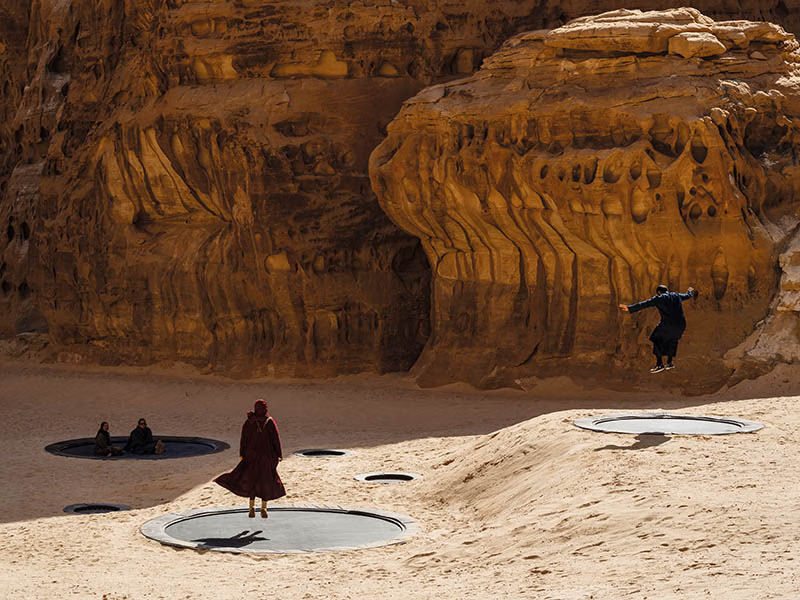
Now You See Me, Now You Don’t (2020)—the words a humble puddle in the Saudi desert might say to a curious visitor—is a landscape installation AlDowayan created for the inaugural Desert X AlUla. Photograph courtesy of Lance Gerber and the artist.
She is proud that a lot of her artworks are today considered historical: “I think art has a very important part when writing a nation’s history.”
Born in Dhahran, a city that exists because of Saudi Aramco, AlDowayan has made art since she was a child, and in her twenties gained gallery representation. But she stayed in Dhahran working for Aramco. “I didn’t believe in myself,” she recalls. “I was young, and I never saw a Saudi woman artist that was successful and living as a full-time artist.” But she quickly arrived at the point that she needed to be fully committed to art: “Everyone was against my decision,” she says. “But when you’re born to be an artist, either you do it or you live a very unfulfilled life.”
A constant during her career has been the support of women. From her mother, who bought her first camera and sent her money to attend art classes while she studied computer science in London, to Delfina Entrecanales, late founder of the Delfina Foundation, who saw AlDowayan’s show in Bahrain and offered her an art residency in London: “This old woman became my art grandmother. She was the first to tell me: girl, you’re an artist.” She accepted the residency, submitted her resignation, and packed her bags: “I just felt this was my sign.”
After the residency, she went back to Saudi Arabia to take care of her ailing father. His passing inspired one of her most touching series of artworks, And I, Will I Forget? “They were really a way for me to heal,” she says. “I’d say my artworks are just a life lived.”
By now a full-time artist, AlDowayan started to connect with the local art scene. Her seminal series Crash—which documented in photographs the number of Saudi female teachers injured or dying in car accidents—was exhibited in a solo show in 2014 in Dubai.
As the kingdom opened to new art initiatives, such as the first Desert X AlUla in 2020, AlDowayan started presenting more playful works such as Now You See Me, Now You Don’t—a series of puddle-like installations in the desert, made of massive trampolines meant to be used by visitors.
Today her works are found in institutions around the world, including the British Museum, Centre Pompidou in Paris and Doha’s Mathaf.

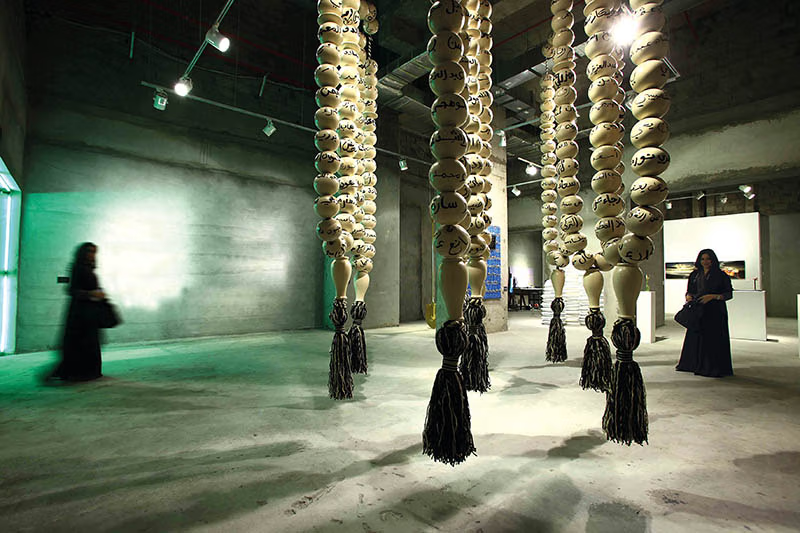
I Am a Saudi Citizen (2005), top, a gelatin silver print from the I Am collection, which addressed women’s contribution to the development of Saudi society. Esmi – My Name (2012), above, maple wood beads with natural wool rope handmade by Bedouin women. Photographs courtesy of the artist.
SHIFTING SANDS
For the Venice show, AlDowayan went back to women, creating an artwork that is a culmination of her practice. It explores the evolving role of women in Saudi public life and their journey to redefine both the space they inhabit and the narratives that have defined them—within the kingdom and beyond it. “I’ve been blessed in the way women have supported me, so for Venice I couldn’t do an artwork that was not a thank you to my sisterhood.”
The work, Shifting Sands: A Battle Song, is an immersive multimedia installation that includes sculpture and sound. It consists of a series of soft sculptures—a recurrent element in her practice—made of silk and shaped like a desert rose. “The desert rose is a very rough material that you can crack with a sledgehammer. But to remove the rock medium and change it to something soft, like fabric, it becomes something you can’t crack. Fabric can dissolve if you let it drop, but if you lift it up again, it regains shape, like a phoenix rising from the ashes.”
AlDowayan uses the surfaces of the sculptures like skin, covering them with “tattoos,”—a collage of the typical terms used by Western media to describe Saudi women. “This language has surrounded me personally,” she says. “As a woman, wherever I travel with my art, I have to respond to this misunderstanding absorbed from the media. People would speak about me to my face but forget to ask me about my own experience and humanity. With this work I wanted to emphasise how the media is creating a collective memory and perception.”
The artwork takes inspiration from traditional dances of the Arabian peninsula. Typically performed by men, participants are roused in chorus by a central figure, a poet or dancer. Here, the silken sculptures that span the hall represent the poet. Emanating from either side are women’s voices in low, synchronised humming—a poetic and unified battle cry. In workshops she organised in three Saudi cities, AlDowayan asked 1,000 women and girls to sing.
She blended their voices with the sound of “singing” sand dunes—a phenomenon found in the Empty Quarter of Saudi Arabia that she experienced with geologists at Aramco. She went back to the desert to capture it. She recorded it, put it in headphones, and asked the women to harmonise with it. She also collected their responses to the terminology used to define them by Western media. She overlaid their words and drawings onto the silken sculptures, part obscuring the collage. An attempt to bring the words, and voices, of Saudi women to the fore.
DIRTY HANDS
Entering the Saudi pavilion, viewers must engage all their senses. They might start reading the cacophony of media titles printed on the fabric, but they are soon drawn to the centre of the installation by the
women’s voices. There I remembered something AlDowayan had told me, speaking of when she was still a young artist working at Aramco. She would talk with a writer, “I told him that I wanted to do artworks [that] discuss the conservative establishment’s control on women’s bodies, and he warned me, ‘If you tackle this topic, you’ll be playing with charcoal. You will get dirty and you will never become clean.’
“These words were burned inside me,” she says. “So when Saudi Arabia started changing I decided, ‘You know what? I’m getting my hands dirty with charcoal.’”
Standing in the pavilion, looking at the sculptures, I noticed that every silk panel was dirty. All dirtied by charcoal.
A state of the soul
In a world marked by war and migration, Middle Eastern artists in Venice rewrite old narratives at the 60th International Art Exhibition.
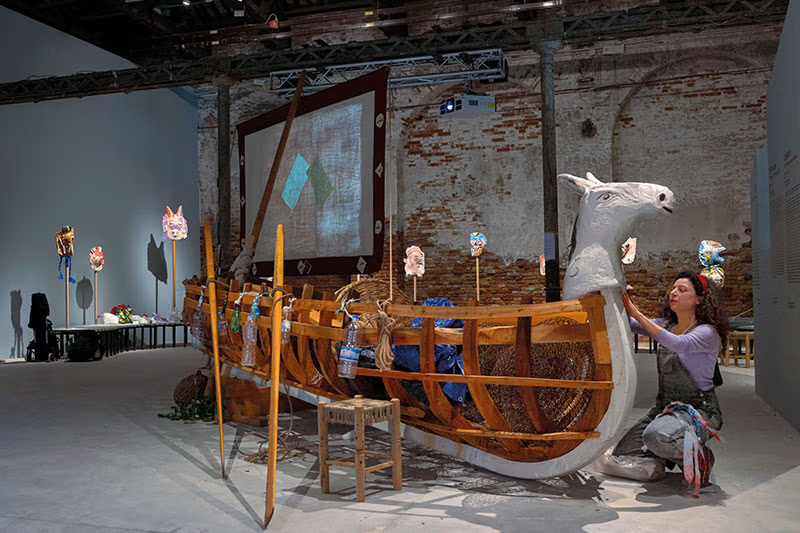
A Dance with her Myth, top, by Mounira Al Solh, representing Lebanon, gives a feminist retelling of Greek Phoenician mythology, particularly the myth of Europa. Photograph by Federico Vespignani. Photograph courtesy of Sfeir-Semler Gallery Beirut/Hamburg.
Being a foreigner is more than a state of mind. It is a state of the soul. The foreigner’s journey can be painful or enriching. Often it is both, as illustrated by a number of Arab artists at the 60th International Art Exhibition in Venice, which continues through November 24.
Stranieri Ovunque, or Foreigners Everywhere, the theme of the Biennale chosen by curator Adriano Pedrosa, subverts the linear Western art trajectory by bringing outsider narratives to the forefront. The theme allows for explorations of identity, ethnicity, gender and belonging.
In the main exhibition in the Giardini, Lebanese artist Omar Mismar posits being an outsider as a fascinating discovery. He uses an ancient mosaic technique to depict two lovers. For Moroccan artist Bouchra Khalili, the journey far from home is tortuous and perilous. For her striking video installation, The Mapping Journey Project, she asked migrants—refugees and the stateless—to trace on maps their routes across the Mediterranean to Europe.
Some 40 Arab artists are exhibiting at the Biennale. While Arab artists cannot be considered marginal—they have long participated in the global art conversation—many still work to dismantle biased narratives and prejudices about, and within, the Arab world. There are six MENA pavilions, too. Here, some Middle Eastern artists chose to excavate myths to tell contemporary stories (Lebanon and Egypt). Others to challenge perception and stereotypes (Saudi Arabia).
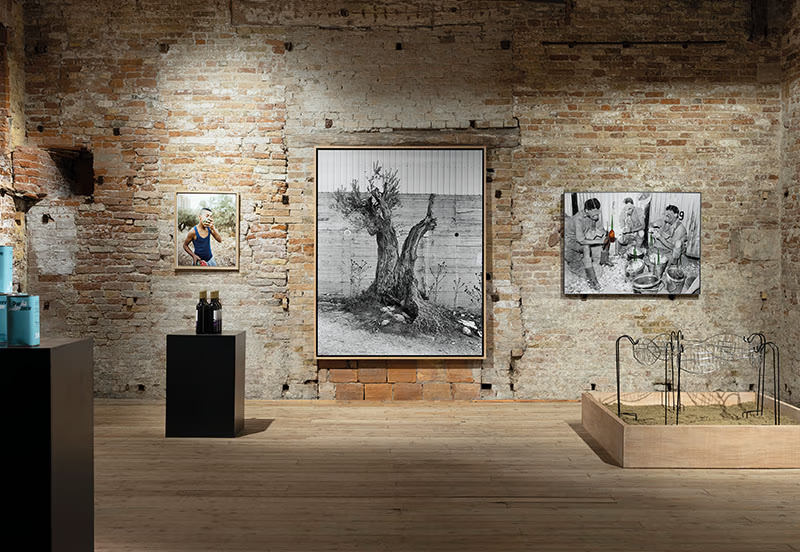
Foreigners in their Homeland, a highly political collective show, includes emerging and established Palestinian artists. Photograph ourtesy of Artists + Allies x Hebron and Dar Jacir.
Artist Mounira Al Solh, representing Lebanon, gives a feminist retelling of Greek Phoenician mythology, particularly the myth of Europa. In her multimedia installation titled A Dance with her Myth, a boat at the centre of the pavilion is surrounded by large-scale paintings, drawings, sculptures, embroidery, and video. Al Solh tells the story of the abduction of Princess Europa by Zeus in the guise of a bull, but she does it from Europa’s perspective, reframing Europa as a figure with agency, rather than a victim of destiny. The boat invites visitors on a symbolic journey of emancipation. That the boat is unfinished suggests the journey is not completed.
Similarly, the Egyptian Pavilion reimagines local narratives, addressing national history and colonialism through drawing, sculpture, and a mesmerising video. In the colourful, almost satirical film, Drama 1882, artist Wael Shawky examines Egyptian history from Arab perspectives, rather than through the eyes of the colonisers. He turns orientalism on its head with an ironic vein, so much so that historical figures become almost comical figurines from a child’s novel.
Not content with a pavilion to himself, Shawky’s second show, at the spectacular Palazzo Grimani, brought visitors from the banks of the Nile to the slopes of Mount Vesuvius. Shawky’s research on Greco-Roman mythology and Pompei is rendered in a beautiful film, I Am Hymns of the New Temples, reminiscent of Fellini’s Satyricon, and reimagines classical tales. Shawky highlights the multifaceted nature of myth, which corresponds to the interweaving of Mediterranean cultures.

The Mapping Journey Project, top, by Moroccan artist Bouchra Khalili, asked migrants to trace on maps their routes across the Mediterranean to Europe. In his satirical film. Photograph by Marco Zorzanello, courtesy of La Biennale di Venezia.
Gulf states share their connection to the desert. Side by side, the Saudi and Emirati pavilions evoke dunes and open spaces, conducive to poetry. In Shifting Sands: A Battle Song, Manal AlDowayan gathers the singing voices (and battle cries) of Saudi women, harmonising them with the sound of the wind passing over dunes. With soft sculptures at its core, the work explores the role of women in Saudi public life, and their perception abroad.
While Saudi Arabia focuses on the collective, the UAE explores a solo journey. With his exhibition Sites of Memory, Sites of Amnesia, Emirati artist Abdullah Al Saadi details his solitary travels in the desert. Inspired by classical Arab poets—who immersed themselves in the landscape to connect to a higher power—he presents maps, stones, scrolls, and drawings created in the wilderness. The message that emerges is about not overlooking those little moments of grace, as well as the human need to keep the memory alive through tangible objects.
At the Oman pavilion, a collective show titled Malath-Haven explores Oman’s multicultural legacy. Malath means “safe space”, a harbour where travellers—sailors, merchants and migrants—can find shelter and kinship. Curator Alia Al Farsi sought to depict Oman as a haven throughout history. From Al Farsi’s work using colourful garments and mirrors to Ali Al Jabri’s Water, exploring the concept of luck in finding a better life, the pavilion is conceived as an immersive experience. In Madad, Essa Al Mufarji uses Arabic calligraphy to reflect on ancient poets and their impact on perceptions of migration. Sarah Al Olaqi’s Breaking Bread explores women’s roles in preserving traditions through recipes and showcases a giant niqab sculpture. Adham Al Farsi’s The Fate of Outsiders uses video installation to tell the story of turtles as a metaphor for outsiders.
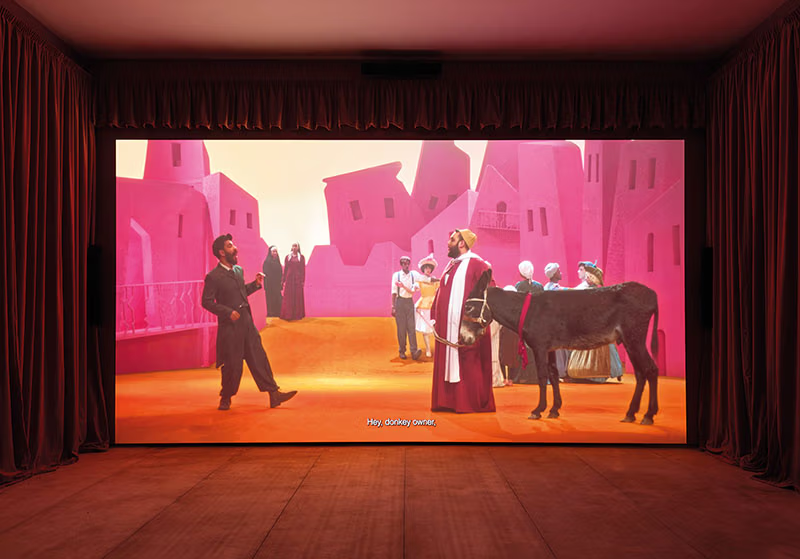
Drama 1882, bottom, artist Wael Shawky examines Egyptian history from Arab perspectives, rather than through the eyes of the colonisers. Photograph courtesy of Sfeir-Semler Gallery, Lisson Gallery, Lia Rumma and Barakat Contemporary.
While Oman looked to the unity of one country to find multiplicity, Qatar looked at multiple countries to find a sense of unity. Qatar Museums presents narratives not only from Qatar but the broader Arab and Muslim world. With an elegant show in the ornate Palazzo Franchetti, the video exhibition Your Ghosts Are Mine: Expanded Cinemas, Amplified Voices comprises excerpts from more than 40 films and videos by Arab and African artists and filmmakers. An interesting aspect is the blurring of cinema and video art through pieces like Ali Cherri’s The Dam, which follows a Darfuri seasonal worker who builds a monumental mud-brick work during the night.
Palestine is present in three shows (and many other artists used their work to make statements as the art world processes the brutal war in Gaza). The official collateral exhibition, South West Bank, presents the work of artists in residency at the Dar Jacir art initiative in Bethlehem. The show Foreigners in their Homeland, a highly political collective show, includes emerging and established Palestinian artists. In one striking work, Gaza artist Maisara Baroud documents the destruction of his homeland through a series of angular, black-and-white sketches which hang in front of a window in the Palazzo Mora. A third show, The Horse Fell Off the Poem, is a haunting painting exhibit that addresses the war by Gaza artist Malak Mattar. —Naima Morelli



